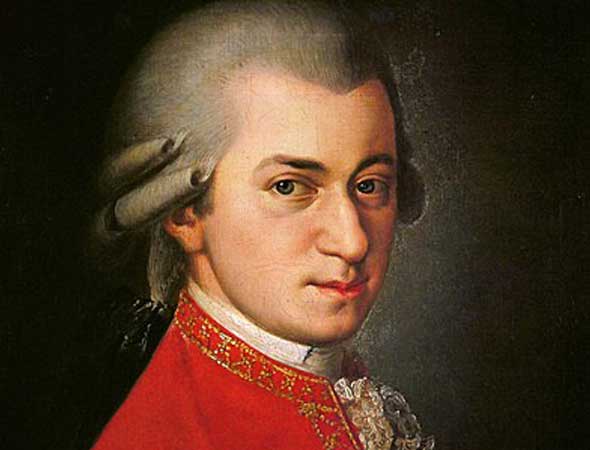MOZART: Piano Concerto No. 20
Instrumentation: flute, 2 oboes, 2 bassoons; 2 horns, 2 trumpets; strings; percussion; solo piano.

Wolfgang Amadeus Mozart
When Mozart astounded the courts of Europe with his feats of musicality in early childhood, no one could know what lay in store for him. But what followed was even more remarkable: three decades of prolific musical composition during which his blazing precocity flowered into early maturity. Works he created as a teenager seem to reflect facility honed over a lifetime. Which was the first that could be called “masterpiece?” Opinions vary, but more than one musicologist has singled out Mozart’s first great piano concerto: No. 9, written when he was 17. When he completed the 20th, in 1785, Mozart was a 29-year-old married man living in Vienna. It is now universally recognized as one of the towering concertos in his catalogue, but this has meant different things to different generations of listeners.
In the years 1784 and 1785, piano concertos were among the high watermarks of Mozart’s creative output. He had written five great piano concertos in 1784 alone. These generally hewed to the expectations of their contemporary audiences, introducing themselves with a briskly paced opening movement previewing all the beguiling melodies to come like beads on a string of orchestral discourse. After a graceful central movement of stately pace, a joyful final movement—energetic and quick—brings the concerto to a close, typically with a rondo or theme and variations.
Public preferences changed once Beethoven reinvented the piano concerto, especially with his Nos. 4 and 5. His expansion of the form to grapple with great ideas seemed made-to-order for the Romantic era, pitting the lone soloist against the arrayed forces of the orchestra in a way that embodied the questing philosophical spirit of the times. With the rise of great solo pianists and the public fascination with virtuoso display, old conventions were discarded and more dramatic expressive devices—often grandiose and highly emotional—were revealed.
Devotees of the great Romantic piano concertos tended to hear Mozart’s examples, with their singing melodies and perfection of form, as beautiful rather than great. One exception was his No. 20, Beethoven’s favorite, and the one Mozart piano concerto he always kept in his own performance repertory. Today, of course, we have adopted a longer view, understanding that succeeding generations have reconsidered Mozart in stages, the way most listeners discover him. First we hear the divine child with his uncanny knack for divinely beautiful melodies; then the impossibly sophisticated technician, who made complexity sound simple and pushed musical forms to new levels; then the profound, sublime Mozart of compositions such as the Piano Concerto No. 20.
From the opening bars of this concerto, it’s clear why it kept its cachet through the Romantic era and into our own: everything about it defies Classical-era convention while retaining the hallmarks of Mozart’s genius. For one thing, it is in a minor key — rare in classical concertos — that Mozart aficionados will recognize as a portentous one, D minor. He would also choose this key five years later for the scariest section of his opera The Magic Flute: the Act II aria in which the Queen of the Night sings of boiling vengeance, death and despair.
The concerto’s opening builds our eagerness for the music to come, but also riles us with syncopated rhythms and offbeat orchestral textures that seem curiously unsettled. When the piano finally enters the fray, its melodies are not simple tunes suggesting their eventual resolution later in the concerto, but long, twining lines that seamlessly interlock. When a responsive discourse finally arises between orchestra and piano, we might expect the movement to become brighter and simpler; instead, an unstable moodiness prevails, as does the minor key.
The songful melody is a staple of Mozart’s piano concertos, and it is one reason why many listeners hear a special kinship between his concertos and his operas. In this concerto’s second movement, marked romanze, the composer presents us with a prime example: a ravishingly lyrical melody in B-flat major, developed in three parts. Overall, the movement is in the form of a five-part rondo (ABACA), ending with a coda. Its warmth is chilled a bit when Mozart reintroduces themes from the first movement and returns us to a minor-key realm in a section that requires virtuosic passagework from the pianist. Later, as we return to the original major key, the movement resolves in the calmness of a B-flat major triad.
The serenity of the central movement makes the searing energy of the third, marked allegro assai, almost shocking. Its opening jolts us with an unexpected, emphatic arpeggio that sweeps dramatically upward in D minor. Its steep ascent is almost confrontational in tone. As the movement proceeds, a riveting interplay arises between major and minor, between earlier and later thematic materials. It concludes with a magnificent finale that somehow unifies seemingly conflicting elements without compromising them.












